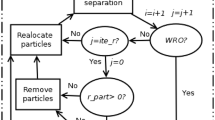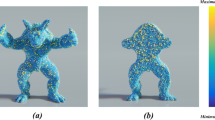Abstract
Specimen generation by packing of particles is the initial step in most numerical simulations for discrete media. In many cases, especially for virtual soil compaction, filtration, or penetration tests, this preparation work is essential for the success of the tests because the discrete particles are not able to be redistributed during the simulation. This paper presents a novel sphere sequential packing method for specimen generation using the trilateration method and its relevant equations. The method is developed on an assumption that spherical particles must be in contact with at least three neighbour particles to be kept in balance. This semi-analytical method has three advantages: quick generation speed, adjustable porosity, and good control over the spatial distribution of particles at local scale. This paper is a study on two typical spatial distributions: (1) layer-wise, where particles with similar sizes have priority of being positioned next to each other; and (2) discrete, where small particles are located preferentially in between large particles.


















Similar content being viewed by others
References
O’Sullivan, C.: Particulate Discrete Element Modelling: A Geomechanics Perspective. Applied Geotechnics. Spon Press/Taylor, Francis (2011)
Matuttis, H., Luding, S., Herrmann, H.: Discrete element simulations of dense packings and heaps made of spherical and non-spherical particles. Powder Technol. 109(1), 278 (2000)
Reboul, N., Vincens, E., Cambou, B.: A statistical analysis of void size distribution in a simulated narrowly graded packing of spheres. Granul. Matter. 10(6), 457 (2008)
Shire, T., O’Sullivan, C.: Micromechanical assessment of an internal stability criterion. Acta Geotech. 8(1), 81 (2013)
Winkler, P., Sadaghiani, M.S., Jentsch, H., Witt, K.: Scour and Erosion. In: Proceedings of the 7th International Conference on Scour and Erosion, Perth, Australia, 2–4 December 2014. CRC Press, p. 345 (2014)
Ogarko, V.A.: Microstructure and Macroscopic Properties of Polydisperse Systems of Hard Spheres. Universiteit Twente, Enschede (2014)
Bagi, K.: An algorithm to generate random dense arrangements for discrete element simulations of granular assemblies. Granul. Matter 7(1), 31 (2005)
Bezrukov, A., Bargieł, M., Stoyan, D.: Statistical analysis of simulated random packings of spheres. Part. Part. Syst. Charact. 19(2), 111 (2002)
Rodriguez, J., Allibert, C., Chaix, J.: A computer method for random packing of spheres of unequal size. Powder Technol. 47(1), 25 (1986)
Belheine, N., Plassiard, J.P., Donzé, F.V., Darve, F., Seridi, A.: Numerical simulation of drained triaxial test using 3D discrete element modeling. Comput. Geotech. 36(1), 320 (2009)
Sherwood, J.: Packing of spheroids in three-dimensional space by random sequential addition. J. Phys. A Math. Gen. 30(24), L839 (1997)
Buechler, S., Johnson, S.: Efficient generation of densely packed convex polyhedra for 3D discrete and finite-discrete element methods. Int. J. Numer. Meth. Eng. 94(1), 1 (2013)
Oñate, E., Idelsohn, S., Celigueta, M., Rossi, R., Marti, J., Carbonell, J., Ryzhakov, P., Suárez, B.: Particle-Based Methods, pp. 1–49. Springer, Berlin (2011)
Galindo-Torres, S., Pedroso, D., Williams, D., Li, L.: Breaking processes in three-dimensional bonded granular materials with general shapes. Comput. Phys. Commun. 183(2), 266 (2012)
To, H.D., Torres, S.A.G., Scheuermann, A.: Primary fabric fraction analysis of granular soils. Acta Geotech. 10(3), 375–387 (2015)
To, H.D., Galindo-Torres S.A.: Dem gasket website. https://code.google.com/p/dem-gasket/ (2014)
Mechsys website. http://mechsys.nongnu.org/index.shtml (2014)
Fang, B.T.: Trilateration and extension to global positioning system navigation. J. Guid. Control Dyn. 9(6), 715 (1986)
Silveira, A., de Lorena Peixoto, T., Nogueira, J.: In: Proceedings of the 5th Pan-American Conference on Soil Mechanics and Foundation Engineering, Buenos Aires , pp. 161–176 (1975)
To, H.D., Scheuermann, A., Williams, D.J.: In: 6th International Conference on Scour and Erosion (ICSE-6) (Société Hydrotechnique de France (SHF) ), pp. 295–303 (2012)
Langlet, G.: A new fast direct solution to the problem of the sphere tangent to four spheres. Acta Crystallogr. Sect. A Cryst. Phys. Diffr. Theor. Gen. Crystallogr. 35(5), 836 (1979)
Sickafus, E., Mackie, N.: Interstitial space in hardsphere clusters. Acta Crystallogr. Sect. A Cryst. Phys. Diffr. Theor. Gen. Crystallogr. 30(6), 850 (1974)
Lagarias, J.C., Mallows, C.L., Wilks, A.R.: Beyond the Descartes Circle Theorem. Am. Math. Mon. 109(4), 338–361 (2002)
Galindo-Torres, S., Muñoz, J., Alonso-Marroquin, F.: Minkowski-Voronoi diagrams as a method to generate random packings of spheropolygons for the simulation of soils. Phys. Rev. E 82(5), 056713 (2010)
D’Addetta, G.A.: Discrete models for cohesive frictional materials. Dissertation for Dr. Ing (PhD in Engineering), Stuttgart University, Stuttgart, Germany. http://elib.uni-stuttgart.de/bitstream/11682/206/1/diss_gad.pdf (2004)
O’Sullivan, C., Bray, J.D.: Selecting a suitable time step for discrete element simulations that use the central difference time integration scheme. Eng. Comput. 21(2/3/4), 278 (2004)
Galindo-Torres, S., Scheuermann, A., Mühlhaus, H., Williams, D.: A micro-mechanical approach for the study of contact erosion. Acta Geotech. 10(3), 357–368 (2015)
Cundall, P.A., Strack, O.D.: A discrete numerical model for granular assemblies. Geotechnique 29(1), 47 (1979)
Green, S.: Particle simulation using cuda, NVIDIA Whitepaper (2010)
Xu, J., Qi, H., Fang, X., Lu, L., Ge, W., Wang, X., Xu, M., Chen, F., He, X., Li, J.: Quasi-real-time simulation of rotating drum using discrete element method with parallel GPU computing. Particuology 9(4), 446 (2011)
Thornton, A., Weinhart, T., Luding, S., Bokhove, O.: Modeling of particle size segregation: calibration using the discrete particle method. Int. J. Mod. Phys. C 23(08), 1240014 (2012)
Saucke, U., Brauns, J., Schuler, U.: Zur Entmischungsneigung körniger Schüttstoffe. Geotechnik Zeitschrift 22, 259 (1999)
Chang, C.S., Misra, A.: Packing structure and mechanical properties of granulates. J. Eng. Mech. 116(5), 1077 (1990)
Oda, M., Nemat-Nasser, S., Mehrabadi, M.: A statistical study of fabric in a random assembly of spherical granules. Int. J. Numer. Anal. Meth. Geomech. 6(1), 77 (1982)
Powell, M.: Computer-simulated random packing of spheres. Powder Technol. 25(1), 45 (1980)
Kumar, N., Imole, O.I., Magnanimo, V., Luding, S.: Advanced Materials Research, vol. 508, pp. 160–165. Trans Tech Publ, Clausthal-Zellerfeld (2012)
Göncü, F., Luding, S.: Effect of particle friction and polydispersity on the macroscopic stress–strain relations of granular materials. Acta Geotech. 8(6), 629 (2013)
An, X., Yang, R., Zou, R., Yu, A.: Effect of vibration condition and inter-particle frictions on the packing of uniform spheres. Powder Technol. 188(2), 102 (2008)
Budhu, M.: Soil Mechanics and Foundations (With CD). Wiley, New York (2011)
Cho, G.C., Dodds, J., Santamarina, J.C.: Particle shape effects on packing density, stiffness, and strength: natural and crushed sands. J. Geotech. Geoenvironmental Eng. 132(5), 591 (2006)
Acknowledgments
The first author was granted a scholarship from the Vietnamese Ministry of Education and Training (MOET). The support from Australian Research Council (ARC) through the Discovery Grant (DP120102188) Hydraulic erosion of granular structures: experiments and computational simulations is gratefully acknowledged. The simulations were based on Mechsys, an open source library and carried out using the Macondo Cluster from the School of Civil Engineering at The University of Queensland.
Author information
Authors and Affiliations
Corresponding author
Rights and permissions
About this article
Cite this article
To, H.D., Galindo-Torres, S.A. & Scheuermann, A. Sequential sphere packing by trilateration equations. Granular Matter 18, 70 (2016). https://doi.org/10.1007/s10035-016-0666-5
Received:
Published:
DOI: https://doi.org/10.1007/s10035-016-0666-5




